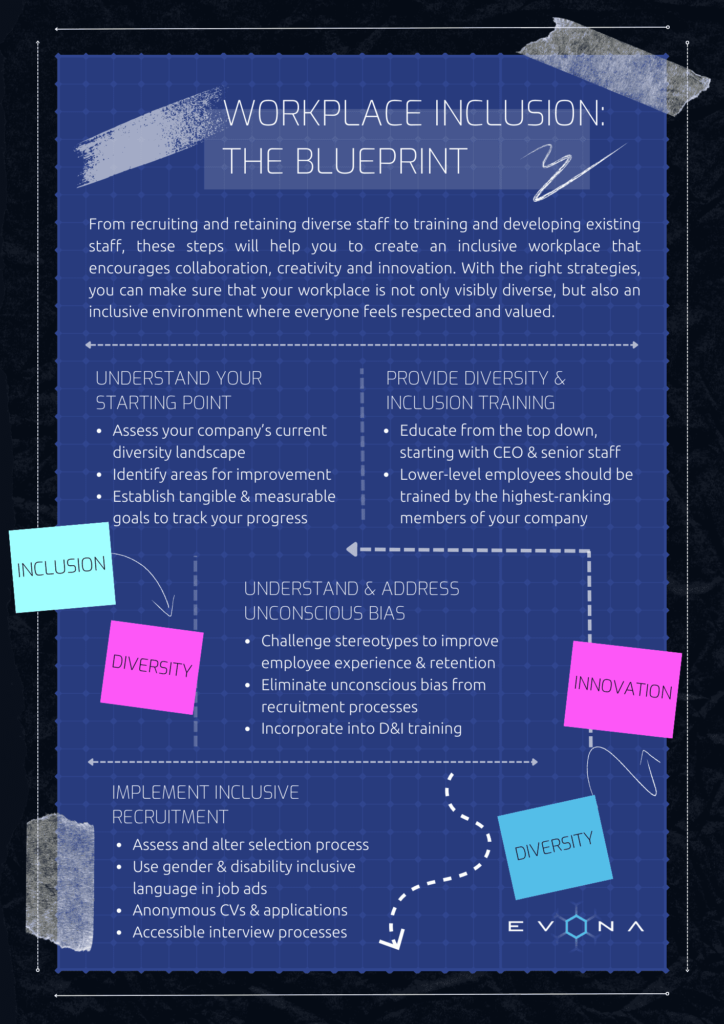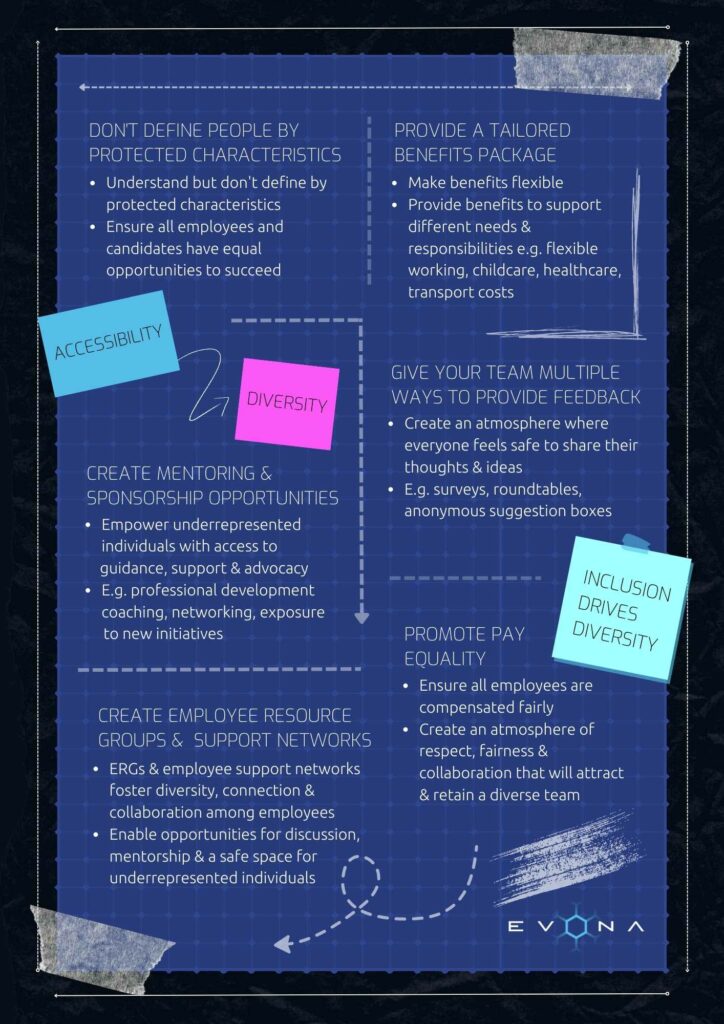Workplace Inclusion: the Blueprint
We’ve said it before, and we’ll say it again — diversity is only achievable through inclusion.
Many companies think that creating a visibly diverse workforce is the first step to building an inclusive one. This is absolutely not the case. Strategically hiring ‘diverse candidates’ to appear inclusive from an outside perspective is completely counter productive to the end goal of true and organic diversity.
The only way to foster a truly diverse team is to create an inclusive environment that attracts and retains people from all walks of life. Not sure where to start? We’re here to help with our guide to building an inclusive workplace.


-
Understand your starting point – set goals, measures and check-ins to track progress
Creating an inclusive workplace isn’t something that can be achieved overnight. It requires a thoughtful and deliberate approach to understand the current diversity landscape within your organisation, identify areas for improvement, and establish measurable goals for progress. This means looking at the makeup of your team and identifying any areas that need improvement. Once you’ve done this, set tangible goals to measure your progress in creating an inclusive workplace, as well as times to check in and review your journey so far. For example, if you want to increase gender diversity on your team, you could set a target of achieving a 30% female representation within six months.
-
Educate your company from the top down – senior members of staff need diversity and inclusion training
Creating an inclusive workplace starts from the top down. Having a CEO who is educated on and visibly committed to inclusion sets the tone for the whole organisation. Similarly, a senior team who understand the importance of diversity and are able to promote its values throughout the organisation, is an essential tool in creating an inclusive workplace. The benefits of this have been academically and statistically proven – companies with leaders who take diversity and inclusion seriously have greater success in hiring, promoting and retaining diverse talent.
It’s also important that lower-level employees have access to diversity and inclusion training. This should be provided by the highest-ranking members of the company. Through diversity and inclusion training, your team can become aware of their own biases and learn how to foster an open and safe environment.
-
Raise awareness and understanding of unconscious bias
People have a tendency to gravitate towards what they feel represents them in some way – their own values, beliefs, experiences, and identity. This can lead to a workplace where the majority of employees look like each other, with similar values, beliefs, and backgrounds. This contributes workplace cultures that are exclusive and not welcoming to those from minority or underrepresented backgrounds.
Unconscious bias happens without our knowledge. It influences how we make decisions, interpret events, and interact with others. It can also have a huge impact on creating an inclusive workplace, as it often involves associating certain characteristics with certain groups. Recognising our unconscious biases is essential when trying to create an inclusive workplace.
-
Analyse your hiring processes and implement inclusive recruitment strategies
Recruitment and selection processes can often contribute to a lack of diversity if they are not properly managed. Throughout the hiring process, it’s important to be aware of unconscious bias. Potential areas of improvement can include anonymous CVs or applications, blind interviewing techniques, ensuring job adverts are free from gender-coded language, and designing tasks that test skills rather than making assumptions. Employers should also consider how they access talent pools, such as widening their geographical search radius or introducing job-sharing roles.
-
Don’t define people by protected characteristics
Employers should strive to create opportunities for all employees to reach their full potential, regardless of personal characteristics. Your website and job vacancies should clearly communicate that your company welcomes applications from all individuals, including those with disabilities and different diversities.
Beyond understanding protected characteristics, it’s essential to move away from letting these characteristics define or limit people. By going beyond compliance with the Equality Act and actively working to create an inclusive workplace, companies can create an environment that will both attract and retain talent.
-
Provide a tailored benefits package – understand your team’s needs and attract candidates from all walks of life
An important part of inclusion is understanding your team’s needs. When creating a benefits package, it’s important to make sure that everyone feels included and respected. Companies need to understand that not everyone has the same needs, and not everyone has the same level of financial resources. It’s important to provide benefits that are both cost-effective and tailored to different individuals’ needs. Benefits can include things like childcare, parental leave, transportation costs, gym memberships, healthcare, and more.
Flexible and remote working have become highly sought-after perks in today’s workforce. Many workers are searching for more adaptable schedules that allow them to better align their work and personal lives. Remote working has also opened up new opportunities for companies as they can now access a wider range of skilled professionals, regardless of their physical location.
-
Create mentoring and sponsorship opportunities to create new opportunities for people from underrepresented groups
Mentoring and sponsorship programmes provide a platform for individuals of all backgrounds to build trust, improve communication, and expand networks. They also increase the visibility of underrepresented individuals, making them more likely to be considered for leadership positions and other opportunities for progression.
Mentoring and sponsorship programmes can include coaching on professional development, networking opportunities, and exposure to new projects and initiatives, among other structures. These programmes empower underrepresented individuals with access to guidance, support, and advocacy from senior and experienced members of your organisation. The mentees and sponsored individuals can bring new perspectives, ideas and skills to the team, increasing diversity and innovation.
-
Give your team multiple ways to provide feedback
Creating an inclusive workplace is a work in progress. Your team’s honest feedback is an invaluable tool in this journey. By providing opportunities to provide feedback in different ways – such as surveys, roundtables, and anonymous suggestion boxes – you create an atmosphere where everyone feels safe to share their thoughts and ideas. When issues arise, you can easily address them and take steps to resolve them swiftly. This can lead to important breakthroughs in the workplace and help build a culture that values inclusion.
-
Promote pay equality
Promoting pay equality in the workplace is not just a moral imperative, but it is also a business-critical strategy. When employers actively work to ensure that all employees are compensated fairly, regardless of their gender, race, or other characteristics, it sends a clear message that everyone will be treated with respect and fairness. This creates an atmosphere of trust and collaboration among employees, which can lead to increased productivity, job satisfaction, and employee retention.
Additionally, promoting pay equality can have a significant impact on your company’s ability to attract and retain top talent from underrepresented groups. Studies have shown that companies with a reputation for pay equality are more likely to attract a diverse pool of job applicants, and employees are more likely to stay with a company that values and respects them.
-
Create Employee Resource Groups (ERG) and employee support networks
Employee Resource Groups (ERG) provide an outlet for employees to connect with others in their demographic, offering the opportunity to discuss shared experiences, access resources, and build community. An ERG is a self-selected, voluntary group of individuals with shared identities or interests that may not be represented in the majority of the organisation. These groups can take many different forms, including affinity groups, resource groups, diversity networks, or ERGs. They can focus on gender, race, culture, ethnicity, nationality, sexual orientation, disability status, and more.
Employee support networks provide a sense of psychological safety and foster collaboration among employees. They are typically cross-departmental groups that provide peer-to-peer mentorship and support. They offer employees a safe space to share concerns and seek advice from colleagues who may have similar experiences or knowledge. Support networks are especially beneficial for employees from underrepresented backgrounds who may not find the same level of inclusion in traditional workgroups.
As a world-leading space recruitment agency, EVONA are committed to illuminating the path to diversity and inclusion in the sector. Our ongoing series, Project Inclusion Drives Diversity (IDD), gives you all the information, insights and practical steps you need in one place. We’re using our own exclusive data and expert insights, alongside advice from NewSpace leaders who share our same vision and are actively implementing these strategies in their organisations.
We’re giving you simple solutions to ensure your company is attracting the best talent, from all walks of life. Download Project IDD Part 1 to find out how to attract, and retain, diverse talent that can take your organisation to the next level. Part 2 coming soon.